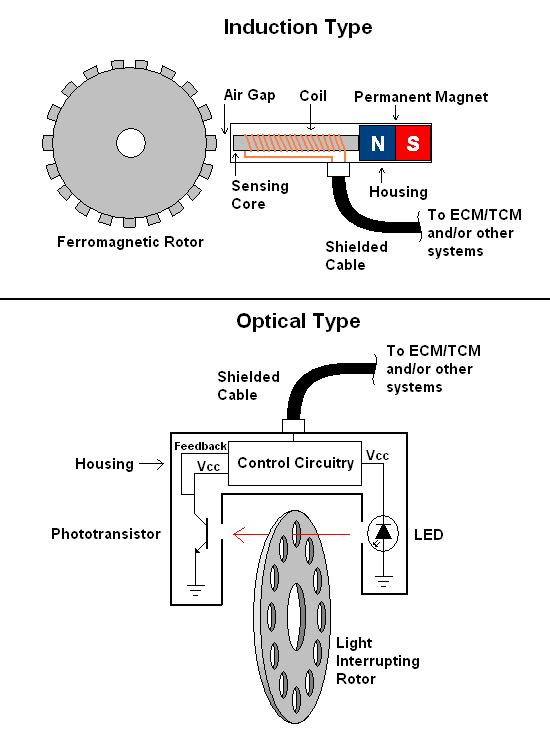Vehicle Speed Sensor
- Basic Description
-
Several automotive systems rely on information about the vehicle speed
in order to function properly. Transmissions rely on vehicle speed information for
optimizing shift strategy. Cruise control systems must monitor vehicle speed in order to
make appropriate throttle adjustments. ABS systems, electronic power-assisted steering
systems and engine control systems also utilize vehicle speed information. Vehicle speed sensors have traditionally been mounted on the transmission or rear
differential, where they monitored the rotation speed of the drive shaft.
These sensors can provide
incorrect information about the vehicle speed if one or more tires do not have good traction
or if the vehicle is skidding. Recently, it has become more common to calculate the vehicle
speed based on information from the wheel speed sensors
associated with the ABS and electronic stability control systems.
Vehicle speed sensors are usually either inductive or optical sensors. The most common inductive sensors consist of a rod magnet on top of a magnetic pin that is surrounded by a fixed coil. This sensor is mounted a fixed distance from a ferromagnetic rotor with teeth. As the rotor turns and a tooth comes into the proximity of the rod, the magnetic flux in the coil changes. This change in flux results in a voltage pulse across the coil. The vehicle's engine control module counts these voltage pulses and computes the vehicle's speed. Optical sensors also generate pulses at a frequency corresponding to the rotor rotation, but instead of measuring magnetic flux, the optical sensor measures either reflected light or light allowed to pass through slits. When using an optical sensor the rotor either has light and dark marks for the optical sensor to detect the reflected light using photosensors, or a series of slits that allows light from an infrared source to pass through and be detected by a phototransistor on the other side.

New technologies are being introduced to provide a more accurate and robust determination of the exact vehicle speed without the need to calculate and average the readings of the wheel speed sensors. Hitachi has developed a low cost compact speed sensor technology that measures the velocity of a vehicle relative to the ground using a millimeter-wavelength radar [1]. This sensor provides the ability to measure velocity even when all 4 tires are slipping.
Another interesting concept that can be used is GPS. Using a GPS sensor, the exact location of the vehicle can be determined, thus the speed of the vehicle can be precisely calculated. A commercially available system based on this principle is the VBOX [2].
- Manufacturers
- Beru, Bosch, Continental, Delphi, Hitachi, Honeywell, Intermotor, Methode Electronics, MSC, Standard, TRW
- For More Information
- [1] Ground speed sensor technology developed for motor vehicles, Physorg.com, Oct. 2008.
- [2] Speed Sensor Comparison, RaceLogic website. [pdf]
- [3]
Vehicle Speed Sensor Description & Related Information , Engine-Light-Help.com
- [4]
How Speedometers Work, William Harris, HowStuffWorks.com, July 10, 2007.
- [5] VSS or Vehicle Speed Sensor, YouTube, Jan. 2008.
|

